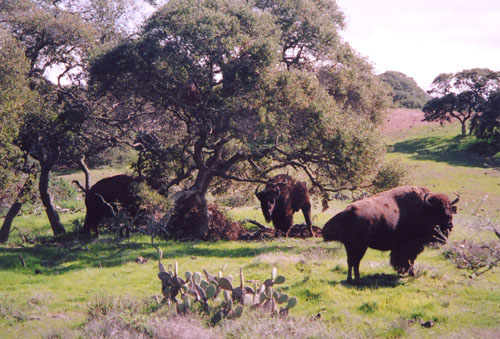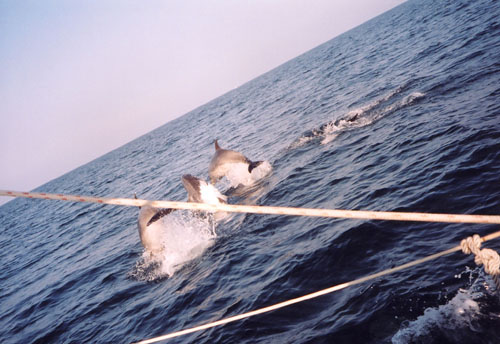

Catalina-Santa Catalina
"Twenty-six miles across the sea
Santa Catalina is a-waitin for me
Santa Catalina, the island of romance, romance, romance, romance"*
So near and yet so far-an hour's ferry ride from Long Beach, California is the famed isle of several songs, and the site of over 200 movies. This was the lovely island I chanced to explore in January 2004. We didn't know what to expect-but, a dozen rolls of film later, I have to tell you it's lovely! And the source of many painting inspirations.
Eighty eight percent of Catalina Island is protected-the Santa Catalina Island Conservancy, founded in 1972, oversees this wonderful island, and so its unspoiled beauty will hopefully remain just that, unspoiled. A naturalist's paradise, a place of wonderful plants and interesting birds and animals-the Catalina foxes, for example, and a great place for diving and snorkeling (not necessarily in January!), with many types of fishes. Even from the shore, though, one sees the bright orange Garibaldi, sometimes known as the "Ocean Goldfish" (since I have seven aquariums of goldfish, the Catalina goldfish alone is almost enough incentive for my presence there!). Twenty-one miles long and eight wide, the coastline features many varied coves, basically reachable only by boat (and there are several day cruise tours available), as the interior of Catalina is a hilly, mountainous region.
Catalina has a most colorful history, beginning with the Gabrielino Indians settling there around 500 B.C. Different Native American tribes lived there, but at the time of European discovery it was the Pimungans (or Pimuvit), who called their island Pimu. This happened in 1592, when Juan Rodriguez Cabrillo (and there is a cove named after him) came there. Since then there has been piracy and looting by various Europeans, occupation of the island by the Spanish, and development of the island by Mexico. Many Native Americans were lost to disease brought on by these new settlers. Suffice to say that eventually Catalina came under USA "ownership" and became part of California. A man named Banning bought the island, starting the Santa Catalina Island Company. Santa Catalina Island Co. was later bought by chewing gum magnate William Wrigley, Jr. and it is he we can thank for basically giving over the island, 88%, to the Conservancy, as well as the fantastic Wrigley Botanical Gardens.
Avalon (yes, like King Arthur's fabled city) is THE (as in "only") city on Catalina, and viewing it from the water, it appears as a pastel, multi-tiered spectacle of houses and trees rising up from the delightful deep blue semi-protected curve of the bay. Anchored on one side by the fabled Casino, a humungous white carved round building with a huge turret-type roof, and on the other by the Green Pier and several impressive turreted Victorians like Mt. Ada (Inn) and Holly Hill House, the whole is backed by the hills/mountains, which in winter are a brownish-green and in summer, rather tropical (although with California's coast having been racked by torrential rainstorms in November and December, and they say Catalina looks more like Hawaii now. Avalon is on one end of Catalina; Two Harbors is almost all the way on the other. This is the "wild" side of Catalina, where Catalina looks almost like an hourglass, with Isthmus Cove and the big pier on one side, plus the restaurant/general store, the grade school, and the small village; Cat Harbor is on the other side-really just for boats, and more protected than either Isthmus Cove or Avalon. I spent a delightful afternoon shell-hunting and photo-taking (bringing a small shoebox of shells back to New Jersey).
If the beautiful scenery and the wildlife is not enough to attract any artist (or anybody) to Catalina, well then, just add the art galleries and Catalina Island Museum to the equation, or the picturesque houses, or other, more modern architecture. There are the Wrigley Botanical Gardens and the Adventure Tours in semi-submersible boats to "ride" through kelp forests. As for the houses themselves, for many of them think Cape May or Plainfield's Crescent Avenue section, or Somerville's older section, but think it in miniature, for these Victorians arose from a tent city years ago. Before there was a city called Avalon, there was Shatto Town, named after George Shatto, who purchased the island in 1887 (Avalon was so-named by George's sister, who was partial to Alfred, Lord Tennyson's "Idylls of the King"). From the late 1880s, visitors stayed in "Tent City" and eventually these sites, 20' wide and 50' long, became the house lots! The area known to locals as "The Flats" in downtown Avalon is on the site of "Tent City"; these dwellings date back to the late 1800s and early 1900s.
One could spend a day tile-hunting. And photographing said tiles. Catalina was once the place for most wonderfully painted tiles, a great tile-manufacturing town. You can still purchase Catalina tiles, although they are not made in great abundance now, but more for the tourists. However, all along the waterfront, the walls are inset with decorative tiles; they are bordered with brightly colored tiles; and the benches and water fountains in town are adorned with them. You only have to look and admire and be totally charmed by the bright colors and varied surfaces! In fact, on our first visit to Catalina, my time was so spent with sea life and plant life, and buffalo, tiles, and walking the streets, I didn't even get into the art galleries! Just let me quickly mention the buffalo, and maybe, the dolphins.

Eighty years ago 14 buffalo (really bison) were brought to Catalina for the making of a western, the 1920s silent movie "The Vanishing American". When the movie company returned to Hollywood, they "forgot" the buffalo. Since the animals grazed conservatively (i.e. they ate only the tops of plants, and not the roots), they did not hurt the island, ecologically speaking, and so the buffalo were allowed to remain. The herd grew, and at times reached 600 head. They are a popular part of the inland adventure and eco-tours! However-the usually sparse vegetation (for Catalina is a semi-arid land, with lots of cactus and dessert palms) ideally supports only 150. The buffalo had to go. In November 98 buffalo were transported from Catalina to South Dakota, the second such emigration. The 98 went from some 42,000 acres on Catalina to 900,000 on the Lakota Indian reservation. A Lakota chief came over to preside over a special sacred ceremony, and as he was speaking, a lone bald eagle flew overhead, very moving!

As for the dolphins, they are there, and on our memorable sail from Isthmus Harbor to Avalon, we were visited by two different pods, who surrounded us, and jumped and played all around us. We were all so excited, and photographing and videoing them, it's a wonder we didn't capsize. The dolphins made their wonderful clicking noises and we talked to them excitedly. One pod left and we saw others in the distance. We called to them and they actually swam over and played with us. Totally amazing! They positively showed off for us, diving under the bow of the boat, and sometimes even jumping in unison.
And so, on this joyful note, I shall end the Catalina Saga, perhaps returning to you with more, perhaps on the art of the island later.
_________________________________
* by Glen Larson and Bruce Belland, sung by the Four Preps, peak Billboard position #2 in 1958
Your comments/questions are welcome. Please send them to
Copyright © 1998-2014, Diana Patton, All Rights Reserved
All photos, images, text, design elements and other content of this website are the exclusive property of Diana Wilkoc Patton, © 1998-2014, and are not to be used without her express written permission, under penalty of applicable copyright laws
(02/05/14)